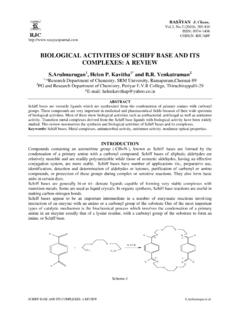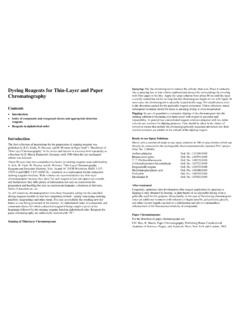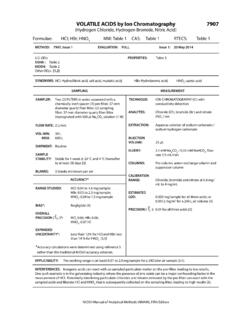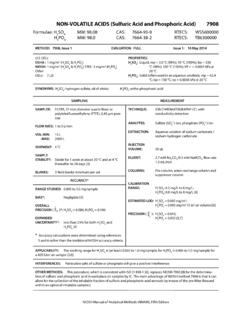Transcription of THE ROLE OF RELATIVE RESPONSE FACTOR IN RELATED …
1 , (2011), 919-943 ISSN: 0974-1496 CODEN: RJCABP STUDIES OF RRF BY HPLC Chakravarthy et al. THE ROLE OF RELATIVE RESPONSE FACTOR IN RELATED SUBSTANCES METHOD DEVELOPMENT BY HIGH PERFORMANCE LIQUID chromatography (HPLC) V Chakravarthy*, G. Kishore Babu, R. Lakshmana Dasu, P. Prathyusha and G. Aparna Kiran Analytical Research & Development, Natco pharma limited, Hyderabad. Pin Code: 500034, Andhra Pradesh, India. *E-mail: ABSTRACT A study was conducted on RELATIVE RESPONSE FACTOR by changing the High Performance Liquid chromatography (HPLC) chromatographic method conditions like different HPLC columns, Flow rate, pH, Temperature, Buffer concentration, Detector wavelength, different Detectors (Ultraviolet & Photo Diode Array Detectors) and different Solvent grades and observed the variations in established RRF.
2 The authors have studied the impact on RRF by changing the Robustness parameters and HPLC columns and all the results were compared. The comparision study has shown that any slight variations in method conditions, the impact is observed on established RRF values. Key Words: RRF, RELATIVE RESPONSE FACTOR , Correction FACTOR , RESPONSE FACTOR , Estimation of RRF. 2011 RAS YAN. All rights reserved. INTRODUCTION RELATIVE RESPONSE FACTOR (RRF) is an analytical parameter used in chromatographic procedures to control impurities/degradants in drug substance and drug product. RRF is used to correct the difference in detector RESPONSE of impurities with analyte peak. RRF is established by slope method with linear range of solutions.
3 Different Pharmacopoeias refer the term RRF differently. As per United States Pharmacopoeia (USP) The RELATIVE RESPONSE FACTOR , is the ratio of the responses of equal amounts of the Impurities and the drug substance1. USP refers RRF as Correction FACTOR or RESPONSE FACTOR or RELATIVE RESPONSE FACTOR . As per European Pharmacopoeia ( ) The RELATIVE detector RESPONSE FACTOR , commonly referred as RESPONSE FACTOR , expresses the sensitivity of a detector for a given substance RELATIVE to a standard substance. The correction FACTOR is reciprocal of the RESPONSE factor2. refers RRF as Correction FACTOR or RESPONSE FACTOR . As per British Pharmacopoeia (BP) The RESPONSE FACTOR is a RELATIVE term, being the RESPONSE of equal weights of one substance RELATIVE to that of another in the conditions described in the test3.
4 BP refers RRF as RESPONSE FACTOR . Establishment of RRF is required to avoid the stability issues with standards, to reduce the cost on preparation of Impurity Standards, to reduce Maintenance of Impurity Standards, due to the lack of donation of Impurity Standards, difficulty in synthesis and isolation of Impurity Standards, for convenience and time saving. RELATIVE RESPONSE FACTOR (RRF) is used in different stages: Phase 1 to Phase 4 studies, in drug purity tests, Mass balance tests, in limit tests, In stability indicating methods etc. EXPERIMENTAL An accurate and precised RS method was developed and the RRF values were established for Imatinib Tablets5. Imatinib Mesylate and Impurity F (Desmethyl impurity) and Impurity G (Isomeric impurity) as experimental drugs, and chromatographic conditions are followed as per Analytical Methodology.
5 A study was carried to observe the variations in RELATIVE RESPONSE FACTOR (RRF) values by changing , (2011), 919-943 STUDIES OF RRF BY HPLC Chakravarthy et al. 920 analytical parameters like change in HPLC columns with same stationary phase with different Column Manufacturers, different detector wavelengths, detectors, column temperature, flow rate, pH, buffer concentration and solvent grade. Estimation of RELATIVE RESPONSE FACTOR (RRF) RRF is estimated by Slope Method. Slope Method: Before establishing RRF, inject Blank solution, Resolution solution and standard solution as per the test method and establish the System Suitability parameters.
6 Prepare not less than seven preparations of Impurities individually and Drug Substance individually in the concentration range of % to % ( , , , , , and ) with respect to test concentration (or) Prepare not less than seven preparations in the range covering three points below the specification level (Above LOQ level) and three points above the specification level with respect to test concentration. Inject the above solutions individually into the HPLC system under test conditions as per the test method. Prepare not less than seven preparations of Drug substance individually and all Impurities mix solution (If mutually interfering peaks of Impurities are not there, then impurity mix solution can be injected) in the concentration range of % to % ( , , , , , and ) with respect to test concentration (or) Prepare not less than seven preparations in the range covering three points below the specification level (Above LOQ level) and three points above the specification level with respect to test concentration.
7 Inject the above solutions (Standard and Impurity mix solution) into the HPLC system under test conditions as per the test method. Prepare not less than seven preparations containing mixture of Drug substance and Impurities (If mutually interfering peaks are not there, of standard and impurities then inject solution containing mixture of Drug substance and Impurities) in the concentration range of % to % ( , , , , , and ) with respect to test concentration (or) Prepare not less than seven preparations in the range covering three points below the specification level (Above LOQ level) and three points above the specification level with respect to test concentration.
8 Inject the above solutions into the HPLC system under test conditions as per the test method. Plot a graph of concentration versus RESPONSE for standard. Do not include Zero in linearity plot. (Concentration on X axis and RESPONSE or area on Y axis) Plot a graph of concentration versus RESPONSE for impurity solutions. (Concentrations of impurity solutions on X axis and RESPONSE or area on Y axis) A graph shall be constructed using all data points following the linear equation ( , y = mx + c) using least squares regression. Determine the slope of individual linearity plots. The Correlation coefficient is not less than for both Standards and Impurities. Useful Formulas: Concentration of API/Impurity* = [Weight (mg)/ Dilution (mL)] X [Molecular weight of Base/ Molecular weight of salt] X Purity (On as is basis) (1) * If molecule exists as salt base then calculate concentration as above.
9 Concentration of API/Impurity* = [Weight (mg)/ Dilution (mL)]X Purity (On as is basis) (2) * If molecule does not exist as salt base then calculate concentration as above. RELATIVE RESPONSE FACTOR of impurity = [Slope of impurity solution in curve/ Slope of standard solution in curve] (3) , (2011), 919-943 STUDIES OF RRF BY HPLC Chakravarthy et al. 921 Note: If the impurity slope value is in numerator, RELATIVE RESPONSE FACTOR (RRF) value appears in the denominator (OR) The RELATIVE RESPONSE FACTOR of the Impurity with respect to drug will appear as divide FACTOR in the formula of impurity determination.
10 RELATIVE RESPONSE FACTOR of impurity = [Slope of Standard solution in curve/ Slope of Impurity solution in curve] (4) Note: If the impurity slope value is in denominator, RELATIVE RESPONSE FACTOR (RRF) value appears in the numerator (OR) The RELATIVE RESPONSE FACTOR of the drug substance with respect to impurity will appear as multiplication FACTOR in the formula of impurity determination. Recovery Studies Calculate the potency of impurity as labeled or as mentioned in specification of drug substance and drug product. For free base as base, for salt as salt and for complex as complex.





